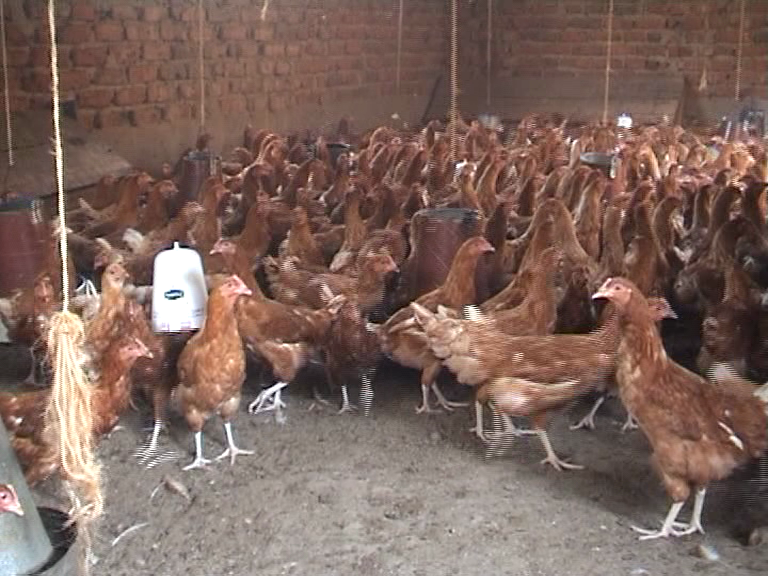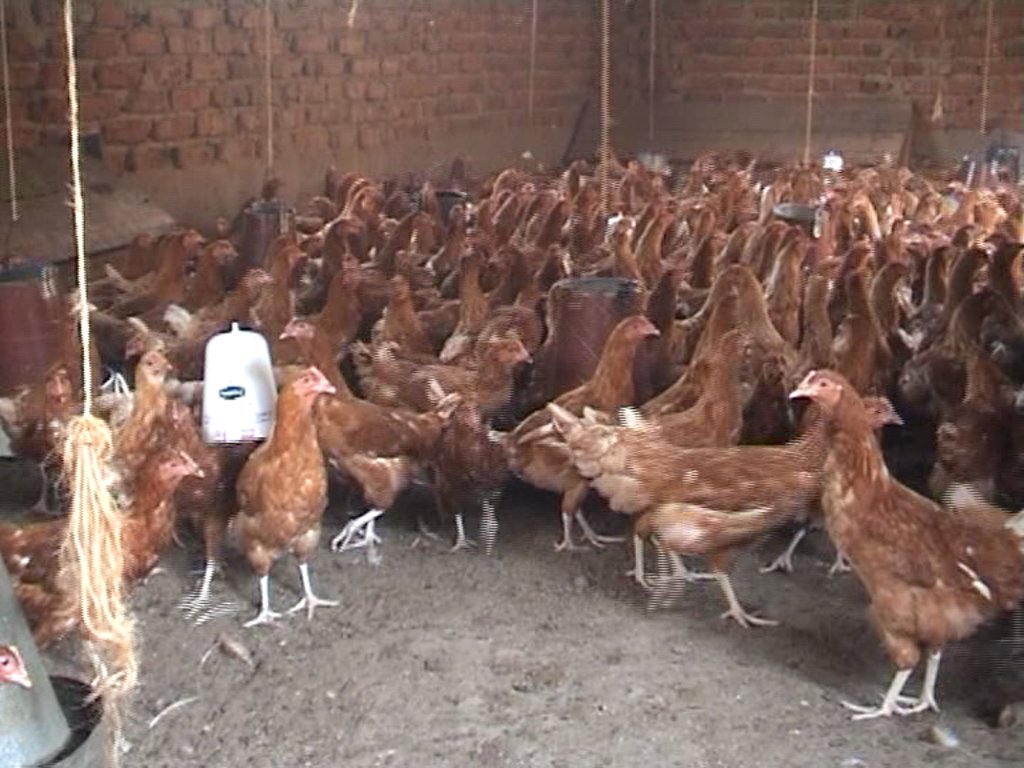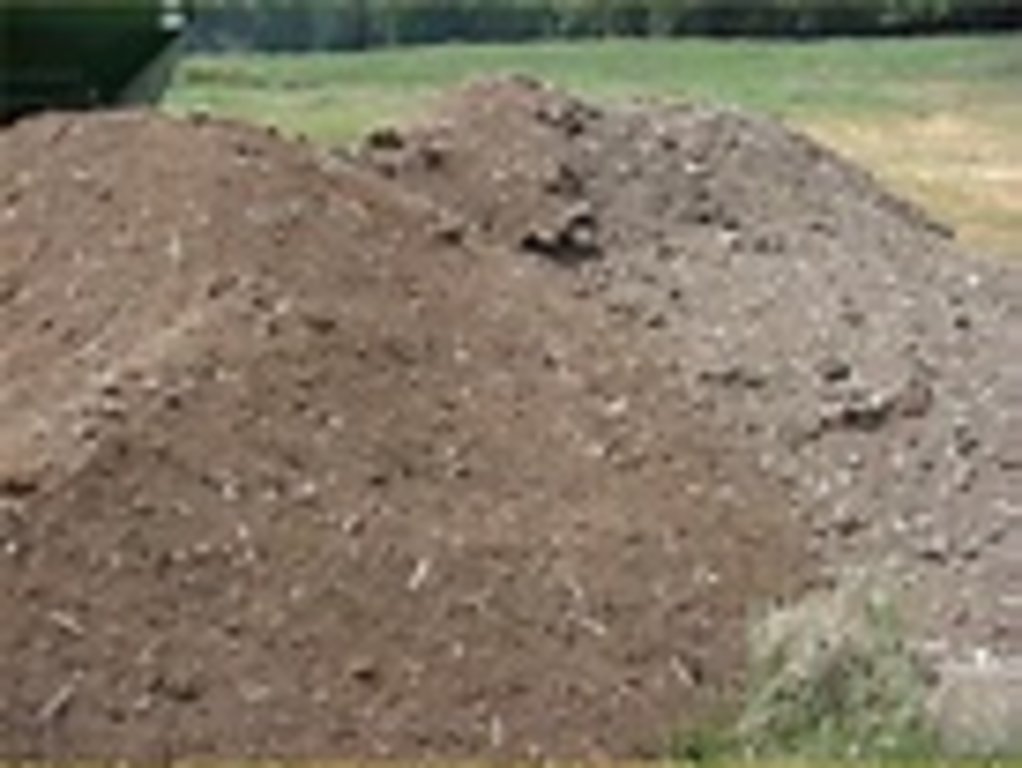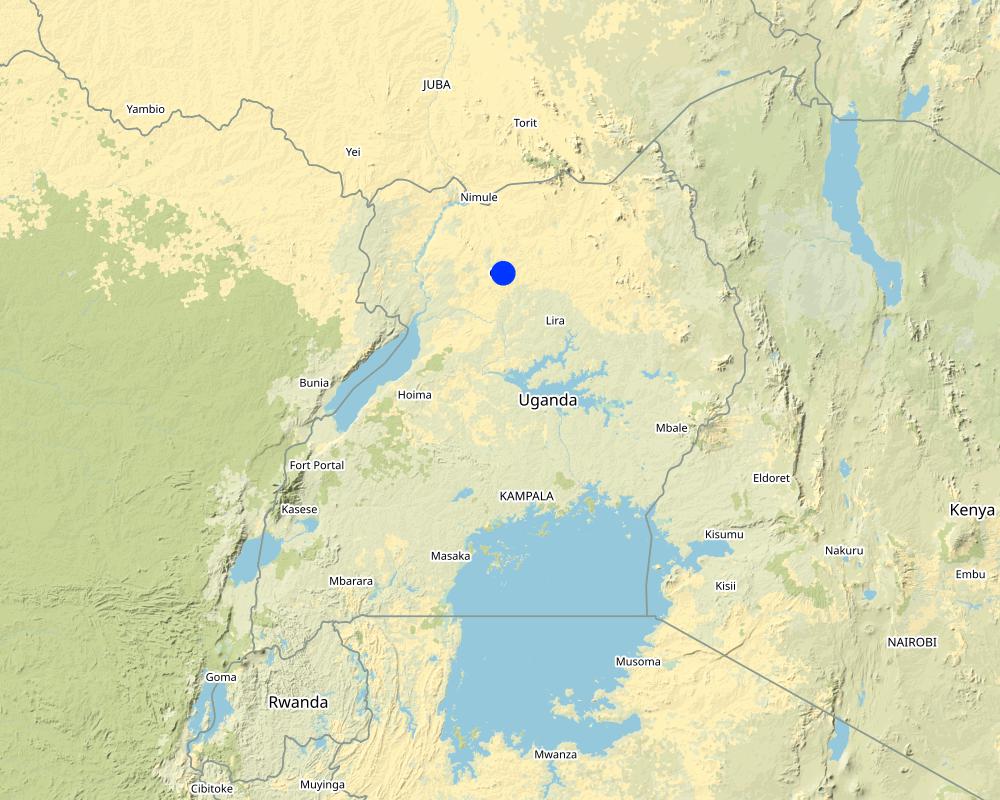Poultry Waste For Soil Fertility Improvement And Increased Production [Uganda]
- Creation:
- Update:
- Compiler: betty adoch
- Editors: JOY TUKAHIRWA, Kamugisha Rick Nelson, Bernard Fungo
- Reviewers: John Stephen Tenywa, Nicole Harari, Stephanie Jaquet, Udo Höggel
Gwoko Gweno Pe Medo Moc Ngom
technologies_2144 - Uganda
View sections
Expand all Collapse all1. General information
1.2 Contact details of resource persons and institutions involved in the assessment and documentation of the Technology
Key resource person(s)
land user:
Kidega Pope
0772605684
Gulu chicken and poultry farmers association
Gulu District, peace division, vanguard sub ward
Uganda
Name of project which facilitated the documentation/ evaluation of the Technology (if relevant)
Scaling-up SLM practices by smallholder farmers (IFAD)Name of the institution(s) which facilitated the documentation/ evaluation of the Technology (if relevant)
CDE Centre for Development and Environment (CDE Centre for Development and Environment) - Switzerland1.3 Conditions regarding the use of data documented through WOCAT
When were the data compiled (in the field)?
27/04/2017
The compiler and key resource person(s) accept the conditions regarding the use of data documented through WOCAT:
Ja
1.4 Declaration on sustainability of the described Technology
Is the Technology described here problematic with regard to land degradation, so that it cannot be declared a sustainable land management technology?
Nee
Comments:
The Technology generates manure which is applied in the gardens to improve soil fertility.
2. Description of the SLM Technology
2.1 Short description of the Technology
Definition of the Technology:
Collected poultry wastes are applied on a planted fruit garden growing mangoes, oranges, jack-fruits, pawpaw, lemon and vegetables such as green peas, tomatoes, cabbages and plantations of pine and eucalyptus for soil fertility improvement and increased production.
2.2 Detailed description of the Technology
Description:
Poultry waste for soil fertility improvement is a common and widely used practice by small scale farmers in Northern Uganda. Manure is collected form the chicken units which are located within a compound. Chicken manure is collected from the compost pit and applied on 1 acre of land or more with the aim of improving soil fertility and increasing production. The method also increases the nitrogen, potassium and phosphorus content of the soil.
The high nitrogen content and balanced nutrients produced by the chicken provide rich manure compost that the land users apply on the farm garden. The garden grows mangoes, oranges, jack-fruits, pawpaw, lemons, vegetables such as green peas, tomatoes and cabbages. The garden also grows pine and eucalyptus trees. Usually chicken manure is kept for decomposting in a hole (decomposting pit), dug into the ground. The manure has the most effective nutrients among all animal wastes and is used as a highly effective measure to improve soil fertility.
To establish and implement this practice, chicken waste is collected from the poultry units using a wheelbarrow and deposited into a decomposting pit dug at a depth of 1 meter. The pit is square in size and its side are 1x1 meter.
The farmer gives the manure three months to break down some of the more powerful nutrients so that they are more usable by the crops before. Thereafter, it is applied using a shovel, a hoe, labour and wheelbarrows. To maintain this technology, the decomposing manure has to be turned after every two weeks for proper breakdown, and clearing around the decomposing pit. Most land users like the technology because it provides manure which improves soil fertility and increases crop production. Surplus manure may be sold and the income so obtained may be used for purchase of other necessary items such as seed, agro-chemicals or other such inputs.
2.3 Photos of the Technology
2.4 Videos of the Technology
Date:
27/04/2017
Location:
Gulu District, Pece Division, Vanguard Sub-Ward.
Name of videographer:
Betty Adoch
2.5 Country/ region/ locations where the Technology has been applied and which are covered by this assessment
Country:
Uganda
Region/ State/ Province:
Gulu District, Northern Uganda
Further specification of location:
Gulu Municipality
Map
×2.6 Date of implementation
Indicate year of implementation:
2012
2.7 Introduction of the Technology
Specify how the Technology was introduced:
- through land users' innovation
Comments (type of project, etc.):
There was need to generate income and also provide manures to the gardens.
3. Classification of the SLM Technology
3.1 Main purpose(s) of the Technology
- improve production
- reduce, prevent, restore land degradation
- preserve/ improve biodiversity
- create beneficial economic impact
3.2 Current land use type(s) where the Technology is applied

Cropland
- Annual cropping
- Tree and shrub cropping
Main crops (cash and food crops):
Fruits, vegetables and trees.

Mixed (crops/ grazing/ trees), incl. agroforestry
- Agroforestry
Main products/ services:
Mangoes, oranges, jack-fruits, pawpaw, lemons, green peas, tomatoes, cabbages, pines and eucalyptus.
3.3 Further information about land use
Water supply for the land on which the Technology is applied:
- rainfed
Number of growing seasons per year:
- 1
3.4 SLM group to which the Technology belongs
- integrated crop-livestock management
- improved plant varieties/ animal breeds
- home gardens
3.5 Spread of the Technology
Specify the spread of the Technology:
- evenly spread over an area
If the Technology is evenly spread over an area, indicate approximate area covered:
- < 0.1 km2 (10 ha)
3.6 SLM measures comprising the Technology

agronomic measures
- A1: Vegetation/ soil cover
- A2: Organic matter/ soil fertility

management measures
- M6: Waste management (recycling, re-use or reduce)
3.7 Main types of land degradation addressed by the Technology

chemical soil deterioration
- Cn: fertility decline and reduced organic matter content (not caused by erosion)

biological degradation
- Bc: reduction of vegetation cover
- Bl: loss of soil life
3.8 Prevention, reduction, or restoration of land degradation
Specify the goal of the Technology with regard to land degradation:
- reduce land degradation
- restore/ rehabilitate severely degraded land
Comments:
Degraded landscape is reclaimed with the help of manure application.
4. Technical specifications, implementation activities, inputs, and costs
4.1 Technical drawing of the Technology
Author:
Betty Adoch.
Date:
27/04/2017
4.2 Technical specifications/ explanations of technical drawing
Chicken waste is deposited into a decomposting pit. The land user integrates fruit trees, vegatables and trees into a garden. A shovel and a hoe is used to mix the manure into the garden.
4.3 General information regarding the calculation of inputs and costs
Specify how costs and inputs were calculated:
- per Technology unit
Specify unit:
Manure decomposing unit
other/ national currency (specify):
UGX
Indicate exchange rate from USD to local currency (if relevant): 1 USD =:
3500.0
Indicate average wage cost of hired labour per day:
5000 UGX
4.4 Establishment activities
| Activity | Type of measure | Timing | |
|---|---|---|---|
| 1. | Composting pit | Management | During dry season, at the time of establishment |
| 2. | Putting the waste into the composting pit | Management | After decomposition |
4.5 Costs and inputs needed for establishment
| Specify input | Unit | Quantity | Costs per Unit | Total costs per input | % of costs borne by land users | |
|---|---|---|---|---|---|---|
| Labour | Digging decomposting pit | Manday | 1.0 | 5000.0 | 5000.0 | 100.0 |
| Labour | Labour for collecting chicken waste | Manday | 5.0 | 5000.0 | 25000.0 | 100.0 |
| Equipment | Wheelbarrow | Piece | 1.0 | 90000.0 | 90000.0 | 100.0 |
| Equipment | Shovel | Piece | 1.0 | 10000.0 | 10000.0 | 100.0 |
| Equipment | Hoe | Piece | 5.0 | 12000.0 | 60000.0 | 100.0 |
| Fertilizers and biocides | 100.0 | |||||
| Total costs for establishment of the Technology | 190000.0 | |||||
4.6 Maintenance/ recurrent activities
| Activity | Type of measure | Timing/ frequency | |
|---|---|---|---|
| 1. | Turning the manure during decomposting process | Management | Every after two weeks |
Comments:
The technology is easy to manage and it requires less labor force.
4.7 Costs and inputs needed for maintenance/ recurrent activities (per year)
| Specify input | Unit | Quantity | Costs per Unit | Total costs per input | % of costs borne by land users | |
|---|---|---|---|---|---|---|
| Labour | Hired labour for turning the compost | day | 14.0 | 5000.0 | 70000.0 | 100.0 |
| Total costs for maintenance of the Technology | 70000.0 | |||||
5. Natural and human environment
5.1 Climate
Annual rainfall
- < 250 mm
- 251-500 mm
- 501-750 mm
- 751-1,000 mm
- 1,001-1,500 mm
- 1,501-2,000 mm
- 2,001-3,000 mm
- 3,001-4,000 mm
- > 4,000 mm
Specify average annual rainfall (if known), in mm:
1000.00
Specifications/ comments on rainfall:
Rainfall is moderate and unreliable typical of a tropical savanna climate.
Indicate the name of the reference meteorological station considered:
Gulu weather station.
Agro-climatic zone
- sub-humid
The region lies within tropical savanna climatic zone.
5.2 Topography
Slopes on average:
- flat (0-2%)
- gentle (3-5%)
- moderate (6-10%)
- rolling (11-15%)
- hilly (16-30%)
- steep (31-60%)
- very steep (>60%)
Landforms:
- plateau/plains
- ridges
- mountain slopes
- hill slopes
- footslopes
- valley floors
Altitudinal zone:
- 0-100 m a.s.l.
- 101-500 m a.s.l.
- 501-1,000 m a.s.l.
- 1,001-1,500 m a.s.l.
- 1,501-2,000 m a.s.l.
- 2,001-2,500 m a.s.l.
- 2,501-3,000 m a.s.l.
- 3,001-4,000 m a.s.l.
- > 4,000 m a.s.l.
Indicate if the Technology is specifically applied in:
- not relevant
5.3 Soils
Soil depth on average:
- very shallow (0-20 cm)
- shallow (21-50 cm)
- moderately deep (51-80 cm)
- deep (81-120 cm)
- very deep (> 120 cm)
Soil texture (topsoil):
- coarse/ light (sandy)
Soil texture (> 20 cm below surface):
- coarse/ light (sandy)
Topsoil organic matter:
- medium (1-3%)
5.4 Water availability and quality
Ground water table:
on surface
Availability of surface water:
medium
Water quality (untreated):
good drinking water
Is water salinity a problem?
Nee
Is flooding of the area occurring?
Nee
5.5 Biodiversity
Species diversity:
- medium
Habitat diversity:
- medium
5.6 Characteristics of land users applying the Technology
Sedentary or nomadic:
- Sedentary
Market orientation of production system:
- subsistence (self-supply)
Off-farm income:
- 10-50% of all income
Relative level of wealth:
- average
Individuals or groups:
- individual/ household
Level of mechanization:
- manual work
Gender:
- men
Age of land users:
- middle-aged
- elderly
Indicate other relevant characteristics of the land users:
The land user is a businessman.
5.7 Average area of land owned or leased by land users applying the Technology
- < 0.5 ha
- 0.5-1 ha
- 1-2 ha
- 2-5 ha
- 5-15 ha
- 15-50 ha
- 50-100 ha
- 100-500 ha
- 500-1,000 ha
- 1,000-10,000 ha
- > 10,000 ha
Is this considered small-, medium- or large-scale (referring to local context)?
- small-scale
5.8 Land ownership, land use rights, and water use rights
Land ownership:
- individual, titled
Land use rights:
- individual
Water use rights:
- communal (organized)
- individual
5.9 Access to services and infrastructure
health:
- poor
- moderate
- good
education:
- poor
- moderate
- good
technical assistance:
- poor
- moderate
- good
employment (e.g. off-farm):
- poor
- moderate
- good
markets:
- poor
- moderate
- good
energy:
- poor
- moderate
- good
roads and transport:
- poor
- moderate
- good
drinking water and sanitation:
- poor
- moderate
- good
financial services:
- poor
- moderate
- good
6. Impacts and concluding statements
6.1 On-site impacts the Technology has shown
Socio-economic impacts
Production
risk of production failure
Comments/ specify:
Due to better supply of soil nutrients for production.
land management
Comments/ specify:
Due to application of high quality manure.
Water availability and quality
water quality for livestock
Quantity before SLM:
low
Quantity after SLM:
high
Comments/ specify:
The tap water is clean and fit for animal consumption.
Income and costs
farm income
Comments/ specify:
From the sale of eggs, manure and mature chicken.
economic disparities
Quantity before SLM:
high
Quantity after SLM:
low
workload
Comments/ specify:
Only hired labour used for collecting manure and its application in the garden.
Socio-cultural impacts
food security/ self-sufficiency
Comments/ specify:
More eggs and income from sale of eggs, manure and chicken which is used to buy other required food stuffs.
health situation
Comments/ specify:
The improved income situation generates sufficient money for the purchase of vital goods.
community institutions
Comments/ specify:
The land user is a member of Agago Poultry Farmers Association.
SLM/ land degradation knowledge
Comments/ specify:
How to apply quality manure on the garden.
Ecological impacts
Soil
soil cover
Comments/ specify:
Increased plant growth due to applied chicken manure in the garden.
soil loss
Quantity before SLM:
high
Quantity after SLM:
low
Comments/ specify:
Plants nutrients bind soil particles together against erosion activities.
Biodiversity: vegetation, animals
habitat diversity
Quantity before SLM:
Low
Quantity after SLM:
high
Comments/ specify:
community of plants and animals exists.
Climate and disaster risk reduction
drought impacts
Quantity before SLM:
high
Quantity after SLM:
low
Comments/ specify:
The trees planted ( Eucalyptus and Pines) modifies the climate through Evapotranspiration. Hence, rainfall formation.
6.3 Exposure and sensitivity of the Technology to gradual climate change and climate-related extremes/ disasters (as perceived by land users)
Gradual climate change
Gradual climate change
| Season | Type of climatic change/ extreme | How does the Technology cope with it? | |
|---|---|---|---|
| annual temperature | decrease | moderately | |
| seasonal temperature | wet/ rainy season | decrease | moderately |
| annual rainfall | increase | moderately |
Climate-related extremes (disasters)
Biological disasters
| How does the Technology cope with it? | |
|---|---|
| epidemic diseases | not known |
6.4 Cost-benefit analysis
How do the benefits compare with the establishment costs (from land users’ perspective)?
Short-term returns:
positive
Long-term returns:
positive
How do the benefits compare with the maintenance/ recurrent costs (from land users' perspective)?
Short-term returns:
positive
Long-term returns:
positive
6.5 Adoption of the Technology
- single cases/ experimental
Of all those who have adopted the Technology, how many have did so spontaneously, i.e. without receiving any material incentives/ payments?
- 90-100%
6.6 Adaptation
Has the Technology been modified recently to adapt to changing conditions?
Nee
6.7 Strengths/ advantages/ opportunities of the Technology
| Strengths/ advantages/ opportunities in the land user’s view |
|---|
| Good at improving soil fertility and increasing production due to application of manure. |
| Very rewarding and can easily be replicated due to its economic benefits. |
| Strengths/ advantages/ opportunities in the compiler’s or other key resource person’s view |
|---|
| Provides positive returns (improvement of soil fertility and increase of production) when applied on farm. |
| Can be promoted by both small, medium and large scale farmers due its benefits. |
| Suitable and appropriate for hired labour which is locally obtained. |
6.8 Weaknesses/ disadvantages/ risks of the Technology and ways of overcoming them
| Weaknesses/ disadvantages/ risks in the land user’s view | How can they be overcome? |
|---|---|
| Manure may affect the crops in the garden if not composted well. | Ensure that only well composted manure is applied on the farm. |
| Takes time to compost resulting into delay in application on farm. | Start the process early enough before planned application of manure on land. |
| Weaknesses/ disadvantages/ risks in the compiler’s or other key resource person’s view | How can they be overcome? |
|---|---|
| Composition of manure if not done well may affect the crop production. | Ensure manure composting process is manged well (collection, putting into the pit, turning and taking to the garden) |
| Requires transport for manure which may result in high costs in cases the garden is far. | Use hired labour which might be cheap. |
| The technology may provide insufficient manure if the planted garden is big. | Integrate other options such as having cows, goats and sheep that can also provide manure but also integrate agroforestry trees for soil fertility improvement. |
7. References and links
7.1 Methods/ sources of information
- field visits, field surveys
01
- interviews with land users
01
7.2 References to available publications
Title, author, year, ISBN:
https://www.gardeningknowhow.com/composting/manures/chicken-manure-fertilizer.htm
Available from where? Costs?
Open access
7.3 Links to relevant information which is available online
Title/ description:
Recycling Improves Soil Fertility Management in Smallholdings in Tanzania February 2018 Agriculture 8(3):31 DOI:10.3390/agriculture8030031 Project: Integrating untapped resources from cooking and sanitation into peasants’ farm-scale nutrient management: a system analysis from the micro perspectiv
URL:
https://www.researchgate.net/publication/323421475_Recycling_Improves_Soil_Fertility_Management_in_Smallholdings_in_Tanzania
Links and modules
Expand all Collapse allLinks
No links
Modules
No modules





